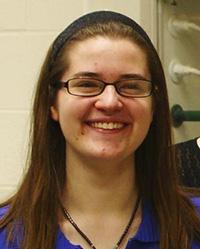Marie Blatnik

Marie Blatnik
Nuclear Physics Graduate Student
I grew up in the midwest (Cleveland area, Ohio), where I would play in the woods and build things out of trash. My undergraduate institution was close to home: Cleveland State University. CSU prepared me for graduate school with its local chapter of the SPS and its Teaching Assistantships (I taught introductory physics labs and did outreach), but it had no nuclear physics. I had decided that I loved accelerator-based science and needed to see what it is for myself, so I joined a summer research program at the University of Illinois at Urbana-Champaign, where I worked on drift chamber development for the COMPASS experiment. From there, I did a National Student Exchange at Stony Brook University, where I joined the PHENIX collaboration at Brookhaven National Lab and worked on particle detector development. This detector development led me to test prototypes at both the Stanford Linear Accelerator and Fermilab's test beam. It was also the first time I drove across the entire United States.
From that list of research, you can see that most of my undergraduate research mentorship (as I figured out what part of science I liked best and got involved) did not take place at my undergraduate institution. I think it's very important to find mentors in the field you are interested in, just as I did as I was a fledgling physicist -- even if they aren't at your institution. This is why I want to join the Alumni Engagement program.
SPS was important to me because it helped me get involved with outreach at local elementary schools, connect with leading scientists through the seminars it held, and it helped to fund many of my research presentations at conferences. The Reporter Award was my favorite, because I could then contribute meeting notes and my experiences after the SPS sent me to a conference.
I met the Ultracold Neutron collaborations at a conference where I was funded by both the Division of Nuclear Physics Conference Experience for Undergraduates and the SPS Reporter Award, and not only did I enjoy the people, but their science sounded fascinating. I joined their research, even skipping classes to make progress, and decided to continue playing with neutrons in graduate school.
Graduate school is this weird grey area in academia where one is a superposition of "student" and "researcher" (http://phdcomics.com/comics/archive/phd083116s.gif). I am a graduate student at Caltech that has finished my classes, and so the rest of my "schooling" is pure research. My typical day consists of building apparatus in the lab, analyzing data using programming (usually Python or C++), and/or scouring the internet for solutions to issues that I don't understand. No day is the same, and no day is without its challenges.
Nuclear physics is a collaborative endeavor. While my institution is Caltech, I am involved in 3 experiments, none of which take place at Caltech. The Spallation Neutron Source neutron Electric Dipole Moment (SNS nEDM) is an experiment that will take place at Oak Ridge National Lab in Tennessee and is in the developmental/design stages. UCNTau (Ultracold neutron lifetime) is an experiment that is taking place at Los Alamos National Lab, and UCNA (Ultracold Neutron, A-parameter) also took place at Los Alamos National Lab and is wrapping up data analysis.
Not everyone goes to graduate school, but my life is typical for those who are pursuing a Ph.D. in any hard science. There are a few twists -- not all hard sciences require as much travel as accelerator-based science, nor the odd hours of accelerator-worshipping.
Beyond math and science classes helping with the "tools of the trade," my education has prepared me for life as a scientist by showing me that there's always another nuance to something that looks obvious from first glance, and by awakening my sense of wonder. More importantly, it has shown me that while passion and excitement is important, it is also important to be driven and disciplined to get oneself over the boring hurdles that accompany the excitement.
Other activities (besides playing with neutrons) include whitewater kayaking, hiking, and fishing. I am a fan of mountains, rivers, and roads.
